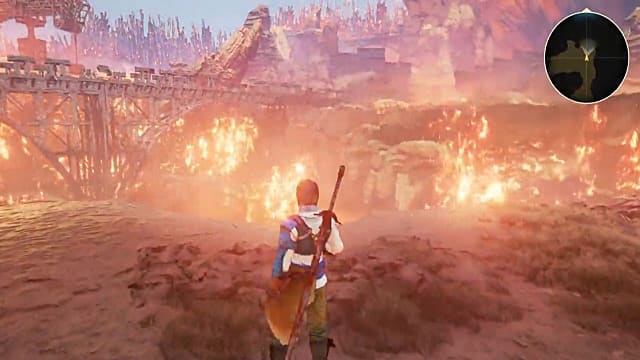Tales of Arise’s protagonist is an amnesiac. A mysterious young woman bursts into his life on a mission to change the status quo, and they’re both hurled into a political conflict between two civilizations. He also can’t feel pain, has no sense of taste except for one specific flavor, and works alongside other Dahnans, enslaved people harvesting energy through stones embedded in them for a dominant civilization.
The opening 30 minutes alone drips with callouts to previous Tales games, especially Symphonia, Berseria, and Abyss. Arise is, for the opening chapter available in the preview build at least, partly celebrating the series and also laying aside some of its now-too-familiar trappings for something more ambitious.
Every recognizable trope has at least one significant twist to keep it interesting — and even valuable — to the narrative. The first chapter left me with a dozen questions and the kind of eagerness to understand them that not many games leave me with, especially so early on.
That goes double for anything to do with Alphen and Shionne, who could easily end up being the series’ best protagonists, but also for the broader story Bandai is telling.
Arise’s opening act is an uprising story and a darn good one at that. It’s no spoiler to say the Dahnans eventually rebel against the lord ruling over Caliglia, presiding over their pain for his own benefit, but the execution (no pun intended) is surprising in its strength.
This is fine!
Alphen and Shionne’s time in Caliglia might be brief, but there’s no escaping the Dahnan’s misery at every turn. Bits of environmental storytelling and sub-quests all help tell the story of the oppressed and, combined with some very good voice acting all around, make not getting caught up in the freedom fighters’ bid for liberation almost impossible.
It’s the kind of story and storytelling that makes Arise feel much more like an epic fantasy than its predecessors.
That shift is significant in another way as well, one that might not sit as well with some. There’s potential to capture the series’ usual lighthearted tone even aside from the skits — my Alphen wore a pair of Shiba Inu ears to the final confrontation with Balseph, Calaglia’s overlord — but so far, there’s no denying Bandai Namco is intent on telling a more serious story with Arise.
Of course, Calaglia is a closed territory gated off by a literal wall of fire. It’s a big world out there, and the one concern I have is whether Arise will maintain its opening excellence, solid pacing, and engrossing story.
Even if some of that does come up short later, there’s still combat to fall back on.
Arise’s combat is equally refreshing so far and the biggest enhancement since Tales of Xillia introduced a heavier emphasis on skills. Berseria’s point-based system returns, where you use normal attacks to charge your TP and chain skill combos, but it also adds new layers of strategy with several new twists.
One is interruption attacks, where, after meeting certain conditions, a party member leaps in with an extra move. It’s handy for dealing extra hurt and vital for encounters with certain enemy types — even bosses.
Another big change is healing, which Arise unchains from TP and links to a separate pool of points. You’ll use this same pool for other important activities, and while it’s essentially shepherding resources the same as you do TP in other games, the new setup changes how you approach combat more than you might think.
That’s not even getting into how Aries builds multiple skill trees in connection with titles gained through the main game and other activities. It has the potential to be a vast system, but one still doled out in easy-to-understand ways.
Of course, the other immediately noticeable difference between Arise and other Tales games is its presentation. Arise is easily one of the best-looking anime-styled games around, and that’s even with just being limited to the land of fire, sand, and death. Some character models lose a bit of their detail when the screen is crowded during cutscenes, admittedly, but it’s nothing too drastic.
Zestiria disappointed with its bland, empty, and outdated-looking overworld, but there’s mostly no danger of that with Arise so far. The wastelands around Calaglia are devoid of life, but not of interest.
There’s substantial attention to detail in everything from flowing water to ruins and even the sound of Alphen’s boots or Shionne’s heels, to say nothing of the things you’ll find in the wilds.
True, most of it is standard fare, such as finding ingredients for cooking or things you’ll need on a quest later, but exploring always feels like a valuable way to spend some time — not something you could say for every Tales game.
In just three hours, Tales of Arise defied my expectations at nearly every turn. It’s a more complete and ambitious package than most of its older siblings, and along with being bold enough to tackle a new kind of storytelling after two decades, it potentially has the foundation to pull it off and land among some of the greats.




